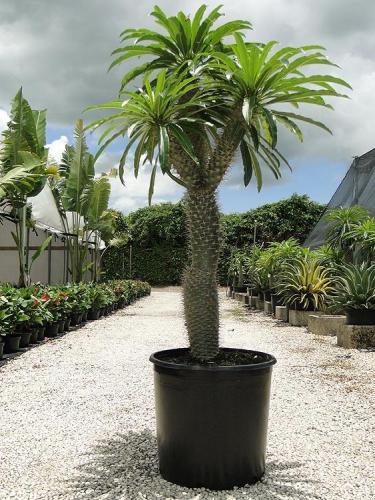As roots fill the pot and soil materials break down into increasingly finer particles, essential resources like oxygen, water, and nutrients, become increasingly difficult for the plant to assimilate. Difficulty obtaining essential resources results in conspicuously slowed primary growth (extension of stems/branches and foliage) with foliage concentrated (again, conspicuously) at the apex (growing tips) of stems and branches where elongation occurs.
The Madagascar palm offers an exceptional opportunity to observe the effects of root congestion and inadequate resources.

The stem of this plant ^^^ reveals it has been up-potted twice. Notice how the thorns become increasingly closer together from the soil line up to the midpoint of the lower stem. The radical change/increase in the distance between the thorns at the middle of the main stem is the result of potting up, which partly eased the stress of root congestion, increasing the rate of elongation. Again, viewing from the midpoint up, you'll notice the vertical space between thorns again begins to decrease until the second repot, after which the plant branched. The branching might have occurred as the result of the reduced stress due to the up-potting, or, it might have been the result of the grower pinching the plant (removing the stem's apex) to force branching.
Additionally, if you haven't been fertilizing regularly, deficiencies of mobile nutrients (nitrogen, phosphorous, potassium, magnesium) force the plant to rob older leaves of nutrients which serve as building blocks the plant needs to produce new foliage. Once the older leaves have been robbed of nutrients, the plant sheds them.
Finally, making sure the intervals between waterings are appropriate are also essential to your plant's well being. Watering too often can limit root function or wreck root health, either/both of which limit the volume of foliage the plant is capable of supporting.
With additional dialog, it's a very good bet the actual underlying cause can be determined more precisely. There just isn't enough information at this point to determine a singular impetus behind the unwanted symptoms. We'll look forward to additional input and any questions you might have.
Al
